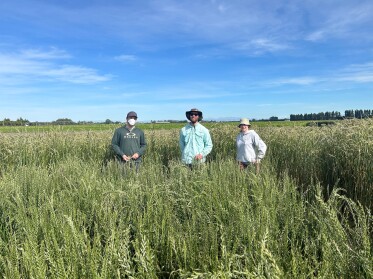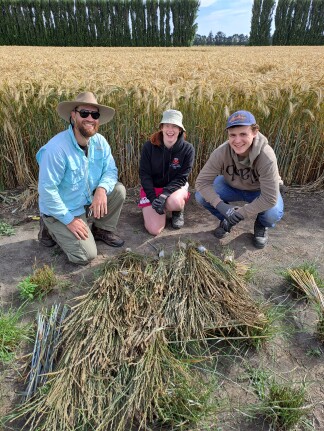At Grasslanz Technology Ltd, we’re committed to supporting the development of future scientific researchers and leaders. Each summer, we host paid student interns, offering them hands-on experience in a real-world research environment, putting theory into practice.
As part of our 2024–2025 Summer Internship Programme, Byron Holdem along with two other interns joined the Grasslanz team to gain insight into the world of applied science and innovation. Here, he shares his experience and reflections from his time with us.
A Summer at Grasslanz: Building a Future in Agriculture by Byron Holdem
From November 2024 to February 2025, I had the privilege of completing a summer internship at Grasslanz Technology’s Lincoln farm. This opportunity arose following the 2023 New Zealand Grassland Association Conference in Rotorua, where I received an award on behalf of my parents for their outstanding environmental practices on-farm. Members of the Grassland Trust encouraged me to apply for the internship, which proved to be a pivotal step in shaping my future in agriculture.
A Passion Rooted in Family
My parents have worked in the dairy industry their entire lives and currently operate a dairy farm in Rotorua. Their dedication to the land and the sector inspired me to pursue a Bachelor of Agricultural Science at Massey University. Now in my final year of study, I’m eager to seize opportunities that help me grow professionally and contribute positively to New Zealand’s agricultural future. The Grasslanz internship has been instrumental in steering me toward this goal.
Learning Through Hands-On Experience
Alongside two other interns — Olivia Shanks from Gore and Ricardo Simari from Argentina — I joined the mini-mult section of the business, focused on mother seed production. This included working with:
- Experimental lines: Individual plants with newly induced endophytes used for trials
- Pre-nucleus lines: New or existing breeding lines maintained to preserve seed quality, with plant numbers ranging from 10 to 350.
Our day-to-day tasks were both varied and technical. We participated in a full cycle of plant management — from identifying heading/anthesis dates and weeding, to harvesting, drying, and grading seed. One of the key tools we used was the Kimseed machine, which filters and sorts seeds by size and weight, ensuring only top-quality seed moves forward in the production process.

From Plot to Product
The work centered around three main stages: prepping, harvesting, and grading.
- Prepping involved checking plots for signs of readiness, like the presence of awns (which can signal contamination), and tying plants for harvest.
- Harvesting included cutting and drying plants (bulk or individual) and preparing them for seed extraction.
- Grading was a careful process of cleaning, sorting, and refining the seed using an air column and the Kimseed machine before determining final seed weight and storage.
These activities helped deepen my technical knowledge, attention to detail, and understanding of the seed production lifecycle.

Supportive Mentorship and Team Culture
Our internship was guided by Katherine Brereton, whose mentorship made even the hottest fieldwork or most repetitive grading task feel worthwhile. Her support fostered a positive, collaborative environment where we all felt valued and motivated.
Shared lunch breaks with Grasslanz and AgResearch staff added to the sense of workplace community. Whether it was solving puzzles or debating the best Christmas movie (I still stand by Home Alone 2), the camaraderie made the experience memorable.
Looking Ahead
This internship has had a lasting impact — enhancing both my academic journey and professional development. I’ve gained valuable industry connections, hands-on skills, and a clearer direction for my future in agriculture.
For anyone passionate about the land and looking for a rewarding summer experience, I wholeheartedly recommend applying for an internship with Grasslanz Technology Ltd.